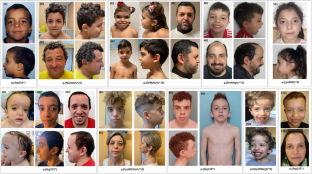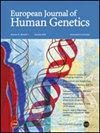ERF的功能缺失变体与伴有或不伴有颅骨发育不良的努南综合征样表型有关。
IF 3.7
2区 生物学
Q2 BIOCHEMISTRY & MOLECULAR BIOLOGY
引用次数: 0
摘要
ETS2 抑制因子(ERF)基因编码一种转录调节因子,对 RAS-MAPK 信号转导起负性控制作用,该基因的致病性变异主要是截短变异,与涉及各种颅缝的综合颅畸形和 Chitayat 综合征有关,Chitayat 综合征是一种伴有呼吸窘迫、骨骼异常和面部畸形的超级罕见病。最近,有报道称,一名患有颅骨发育不全且表型类似努南综合征(NS)的患者携带了 ERF 的一个新功能缺失变体,而努南综合征是 RAS 病中最常见的一种疾病。在此,我们对来自15个无血缘关系家庭的26名携带ERF不同种系杂合变异并表现出类似NS表型的患者进行了临床分析。大多数受试者出现不同程度的全面发育和/或语言发育迟缓。他们共同的面部特征包括绝对/相对巨头畸形、高额头、肥厚、睑下垂、宽鼻梁和低位/后倾耳。三分之二的患者身材低于第三百分位数,没有人表现出典型的 NS 心脏受累。值得注意的是,只有三名无亲属关系的受试者出现颅骨发育不良,而在其他 10 名受试者中,没有任何其他证据表明颅骨缝过早闭合,但却观察到颅骨呈双顶状。有一人被诊断为单侧 Wilms 肿瘤。大多数病例都是家族性的,这表明总体上对健康的影响较小。变异为无义变异和框架移位变异,支持ERF单倍体缺陷。这些发现提供了ERF杂合功能缺失变异导致 "RAS病 "的证据,这种 "RAS病 "类似于伴有或不伴有颅骨发育不良的NS,并首次剖析了导致MAPK信号多态性的分子回路。本文章由计算机程序翻译,如有差异,请以英文原文为准。

Loss-of-function variants in ERF are associated with a Noonan syndrome-like phenotype with or without craniosynostosis
Pathogenic, largely truncating variants in the ETS2 repressor factor (ERF) gene, encoding a transcriptional regulator negatively controlling RAS-MAPK signaling, have been associated with syndromic craniosynostosis involving various cranial sutures and Chitayat syndrome, an ultrarare condition with respiratory distress, skeletal anomalies, and facial dysmorphism. Recently, a single patient with craniosynostosis and a phenotype resembling Noonan syndrome (NS), the most common disorder among the RASopathies, was reported to carry a de novo loss-of-function variant in ERF. Here, we clinically profile 26 individuals from 15 unrelated families carrying different germline heterozygous variants in ERF and showing a phenotype reminiscent of NS. The majority of subjects presented with a variable degree of global developmental and/or language delay. Their shared facial features included absolute/relative macrocephaly, high forehead, hypertelorism, palpebral ptosis, wide nasal bridge, and low-set/posteriorly angulated ears. Stature was below the 3rd centile in two-third of the individuals, while no subject showed typical NS cardiac involvement. Notably, craniosynostosis was documented only in three unrelated individuals, while a dolichocephalic aspect of the skull in absence of any other evidence supporting a premature closing of sutures was observed in other 10 subjects. Unilateral Wilms tumor was diagnosed in one individual. Most cases were familial, indicating an overall low impact on fitness. Variants were nonsense and frameshift changes, supporting ERF haploinsufficiency. These findings provide evidence that heterozygous loss-of-function variants in ERF cause a “RASopathy” resembling NS with or without craniosynostosis, and allow a first dissection of the molecular circuits contributing to MAPK signaling pleiotropy.
求助全文
通过发布文献求助,成功后即可免费获取论文全文。
去求助
来源期刊

European Journal of Human Genetics
生物-生化与分子生物学
CiteScore
9.90
自引率
5.80%
发文量
216
审稿时长
2 months
期刊介绍:
The European Journal of Human Genetics is the official journal of the European Society of Human Genetics, publishing high-quality, original research papers, short reports and reviews in the rapidly expanding field of human genetics and genomics. It covers molecular, clinical and cytogenetics, interfacing between advanced biomedical research and the clinician, and bridging the great diversity of facilities, resources and viewpoints in the genetics community.
Key areas include:
-Monogenic and multifactorial disorders
-Development and malformation
-Hereditary cancer
-Medical Genomics
-Gene mapping and functional studies
-Genotype-phenotype correlations
-Genetic variation and genome diversity
-Statistical and computational genetics
-Bioinformatics
-Advances in diagnostics
-Therapy and prevention
-Animal models
-Genetic services
-Community genetics
 求助内容:
求助内容: 应助结果提醒方式:
应助结果提醒方式:


